The story of The Andover and Redbridge Railway (The Sprat and Winkle Line), written by John Moreton, first published in The Railway Magazine in January 1910.
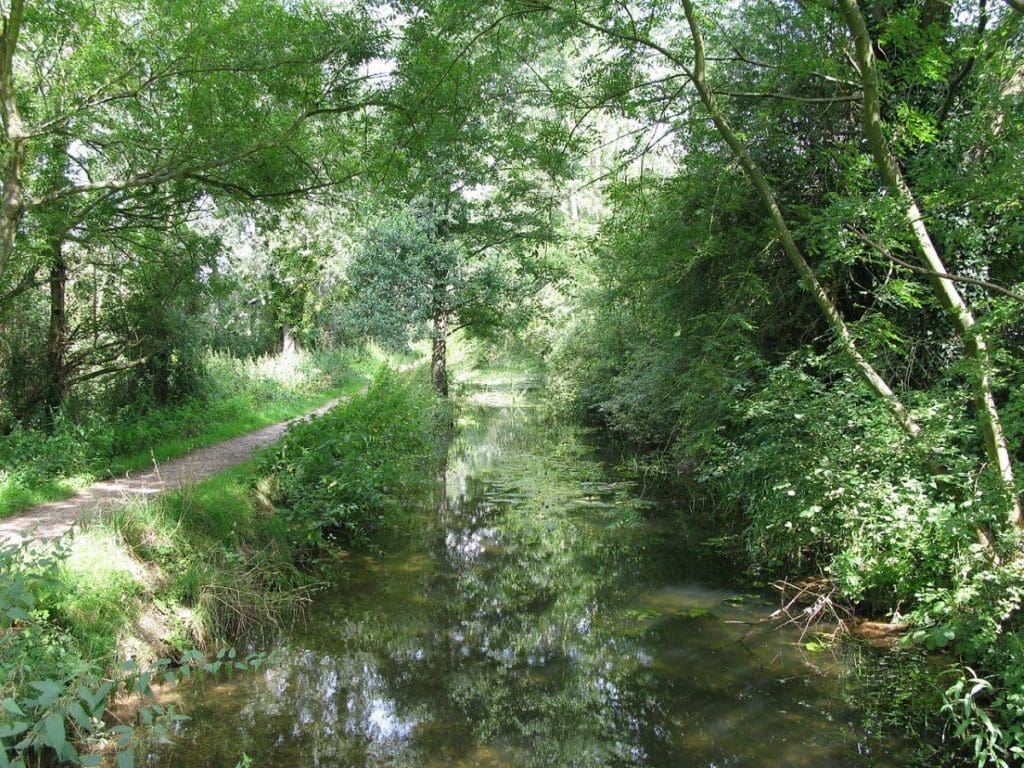
THE curious nickname of “sprat and winkle” line has always been applied to that portion of the London and South-Western Railway running between Andover and Redbridge, in Hampshire. The reason for such a strange appellation is hard to discover, unless it is from the fact that the southern extremity of the line touches the mudlands on the tidal portion of the river Test, where, perhaps winkles may at times be found, but it is questionable whether the silvery sprat is often to be met with in its waters, at or near the spot. The railway itself has a most interesting and somewhat unique history, and provides an illustration of the survival of the fittest insomuch as in this case the railway replaces the canalóthe old waterway giving way to its more formidable opponent, the steam railway.
Again, it forms part of one of the oldest devised schemes for the construction of a railway direct between Manchester and Southampton, and at the present time it provides a most important link in the ultimate outcome of that idea, although, of course, it is by no means the grand trunk line that was originally intended between those two important places.
Enjoy more Heritage Railway reading in the four-weekly magazine.
Click here to subscribe & save.
The Andover and Redbridge Canal that formed the nucleus of the present railway line, was constructed as far back as 1792 – or, at any rate, several miles were then in operation – and for many years this old waterway was used with considerable advantage to the towns and villages which it served, until the railway mania began to disturb the minds of local financiers and landowners; and in the early ‘fifties many meetings were held and schemes discussed for converting the canal into a railway with the idea of shortening the distance between Andover and Southampton. The line from Romsey to Southampton (extension from Salisbury) via Bishopstoke (now Eastleigh), was already in existence at this time.
So far back as the year 1847 the London and South-Western Railway, with the idea of keeping out competitive Great Western Railway schemes, had applied for powers to purchase the canal and convert it into a railway, and Parliamentary assent had actually been obtained, the London and South-Western Railway agreeing to give the promoters of the Manchester and Southhampton Railway, scheme runinng powers over it in the event of the latter obtaining an Act in the following Session. But this excellent arrangement fell to the ground, as in the year 1848 the railway fever had subsided, and no one could be found able or willing to bring such an undertaking before Parliament, so the London and South-Western Railway at this time neglected to avail itself of the opportunity of constructing the line.
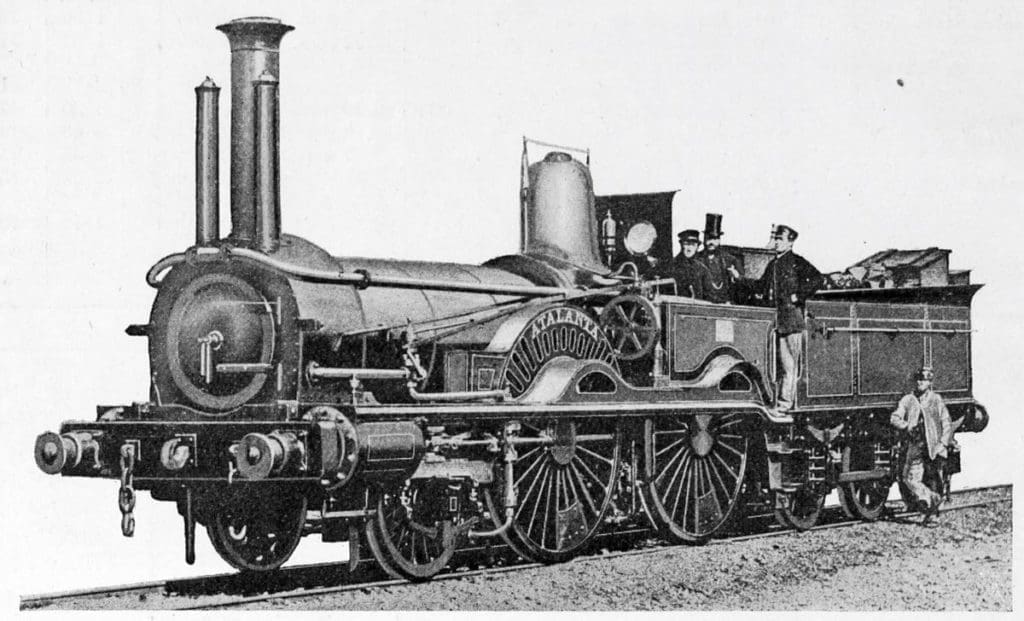
Ten years later this somewhat unimportant part of Hampshire became the centre of the “Battle of the Gauges” that raged so long between the two Western rivals, and on July 12th, 1858, an Act was incorporated for the construction of a broad gauge line between Andover and Redbridge, by means of converting the Andover Canal into a railway, exactly 69 years after the former had been authorised. The capital of the proposed railway was fixed at £120,000, in £10 shares, with authorised loans amounting to £43,000. The purchase price of the canal was fixed at £12,500 in cash and 1,250 shares in the new line. Arrangements were also made with the Great Western Railway to construct a line 14 miles in length from Pewsey to Andover, and thus form a direct ‘broad gauge’ route between Bristol and South Wales to Southampton. After crossing the London and south-Western Railway’s Dorchester line at Redbridge, it was proposed to continue the new railway along the mudlands of the western shore at Southampton to an independent terminus at that town.
It was estimated that the railway would cost about £6,000 a mile to construct, and it was to be formed along the bed of the canal. So far as Southampton was concerned, the inhabitants of that place were most enthusiastic over the scheme, and a member of Parliament is stated to have been elected solely upon his promise to use every endeavour to bring the “broad gauge” to the southern port.
The London and South-Western Railway naturally strenuously opposed the project, and when unsuccessful in this particular, endeavoured to secure the inclusion of a clause in the Bill that the gauge should be 4ft. 8 1/2 in.
In this it also failed, and its next move was to try and make it obligatory on the part of the Andover and Redbridge Railway to construct the line on the mixed gauge, but it was again unsuccessful.
On September 28th, 1859, the first sod was cut by the Rt. Hon. Lord Palmerston, K.G., in the presence of a large and distinguished body of spectators. The site chosen for this ceremony was a field near Ashfield Bridge, occupied by a Mr. Chandler, and just outside Lord Palmerstonís residence, Broadlands, Romsey. To do due honour to the occasion a salute of 14 guns was fired.
Several alterations and modifications were next made in the scheme, and by Act of May 15th, 1860, certain deviations were authorised and the period of completion of works fixed for July 12th, 1863, a date that was subsequently considerably extended.
By Act of July 29th, 1862, the railway was authorised to cancel forfeited shares and to raise new capital to the extent of £15,000 at 5 per cent. preference and £5,000 on mortgage, the time for completion of the works being again extended until January 1st, 1864.
A further Act, dated June 29th, 1863, authorised the Andover and Redbridge Railway being amalgamated with the London and South-Western Railway, and necessitating its construction on the narrow gauge, the latter railway taking up the debenture debt and other liabilities, and securing to the shareholders of the undertaking an annuity equal to 3 per cent. on the payments it had made.
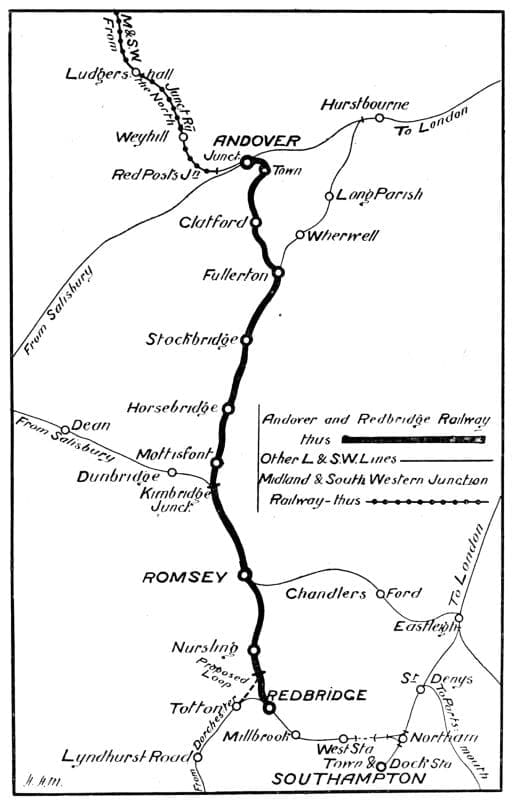
The offices of the Andover and Redbridge Railway were situated in the ancient borough of Andover, and the first Board consisted of the under-mentioned gentlemen: Mr. Ralph Etwall (Andover), Chairman, Mr. Wm. Cubitt (Andover), Mr. Geo. Hunt (banker, Southampton), Mr. John Ravenhill (banker, Warminster), Mr. T. N. Mortimore (farmer, Andover), and Mr. J. P. Stebbings (Southampton). The engineer was Mr. John S. Burke, of 6, Victoria Street, Westminster; the auditors, Mr. Alderman Blatch and Mr. J. N. Swayne; and the solicitors, Mr. VV. T. Manning (London); Messrs. Deacon and Pearce (Southampton); and Mr. T. Lamb (Andover). The qualification for a director was fixed at £500.
The Andover and Redbridge Railway was opened for traffic on March 6th, 1865, and at that time the service consisted of only four trains in each direction (one of which was a mixed passenger and goods) daily during the week, and one train each way on Sundays. It was, of course, a single line, with crossing loops at the stations for trains to pass one another when necessary.
The “mixed” trains occupied over 2 hours for the journey of 28 miles, while the passenger trains, which, of course, stopped at all stations, about 90 minutes.
Seeing that the railway was practically constructed along the route of the old canal, the curves were in places Very bad, and although the line has since been considerably straightened and the curves flattened, there are now many places where the trains perform a half-circle journey from one point to another. This is largely due to the fact that the rivers Avon and Test run parallel with the line all the way, and it was to avoid crossing the latter river too frequently, and the consequent expense in bridging, that these curves were necessary, although, as a matter of fact, the line now crosses the river and its tributaries many times en route. When first opened, a journey on this railway by anything in the nature of a fast train was fraught with considerable excitement and not a small amount of danger to the passenger, and although, fortunately, no accident of a serious nature has to be recorded, many slight mishaps, such as derailments, etc., took place ; and the writer well remembers many journeys on the line where sticking to oneís seat was a matter of considerable difficulty, and the luggage placed on the racks frequently provided a minute bombardment to those seated beneath before the end of the journey was reached.
The gradients throughout the line are particularly easy, except for the short piece between Andover Junction and Andover Town stations, which is on a sharp curve, and has falling gradients of 1 in 62 and 1 in 81 for nearly the whole distance (one mile).
There are a few short stretches of 1 in 120 near Fullerton and Horsebridge, and about 1/2 mile of 1 in 100 just after leaving Romsey.
The stations on this line are as follows: Andover Town, Clatford, Fullerton (where there is now a junction with the branch from Hurstbourne, opened on June 1st, 1885), Stockbridge, Horsebridge, Mottisfont, Romsey, Nursling, Redbridge, Millbrook and Southampton West.

Mr. Sam Fay, General Manager of the Great Central Railway, in his interesting book entitled “A Royal Road,” makes frequent reference to the vicissitudes of the Andover and Redbridge Railway, and devotes a great part of one chapter to the struggles that took place between the two western railways for supremacy inthe proprietorship of the scheme a struggle that eventually landed the originators in Chancery with a contractorís claim amounting to £22,000 against them for work already performed. This, as already stated, resulted in the London and South-Western Railway stepping in and effecting a rescue by amalgamating the railway with its greater neighbour and providing the ways and. means of satisfactorily completing the undertaking.
Many years passed before the line came into actual prominence, and one of the first steps toward this desired end was the policy of the London and South-Western Railway directors in reconstructing it by flattening the curves and doubling the line throughout, which was completed in November, 1885. The opening of the Swindon, Marlborough and Andover Junction Railway (now Midland and South-Western Junction Railway) was the means of providing direct railway communication between the North and Southampton, and completing practically the original idea for a Manchester and Southampton line. The Midland and South- Western Junction Railway now runs through trains over this road, having been granted running powers between Andover and Southampton in return for a similar privilege allowed the London and South Western Railway to Cirencester, but not at present exercised, and passengers are now enabled to travel without change of carriage direct from Southampton to Manchester, York, Bradford, and other large Midland and Northern centres. These are express trains formed of modern bogie stock, electrically lighted and steam heated, and only call at- Southampton West and Romsey, between Southampton Docks and Andover Junction. A very considerable traffic connected with the liners from Southampton Docks is conveyed by this route, and a special train, with passengers for the American, Union Castle and other lines of steamships, runs from the North direct to Southampton Docks on Saturdays.
The district between Andover and Redbridge is, of course, purely agricultural, but being in the valley of the river Test, noted for its famous trout fishing there is during the season a large amount of passenger traffic of a good class from this source and Stockbridge, with its numerous racing stables and training grounds, adds its quota to the annual receipts in the way of conveyance of race horses to and from the various meetings held throughout the country. For many years an annual three days’ race meeting was held at Stockbridge. Where the Bibury Club had their headquarters at the Grosvenor Hotel; but this is now a thing of the past, and the Bibury Club have transferred their patronage to Salis≠bury. The name of Tom Cannon, the famous jockey and trainer, of Danebury, will always be associated with the neighbourhood of Stockbridge.
No particular class of rolling stock was apportioned to this branch railway, but in its early days some ‘relics’ in the form of both engines and carriages were engaged in the service. Many of the older “Beattie” type of engines at one time were running between Andover and Southampton, and the writer well remembers seeing (and occasionally riding on as a boy) the following interesting old locomotives: Reindeer, a 5 ft. 6 in. single engine, with outside cylinders 13 in. by 18 in., small leading and trailing wheels. This old engine was built by Fairbairns in 1843. It had an iron firebox, and the total weight in working order reached only 20 tons 14 cwt. After this came the Havelock, another single engine, but with 6 ft. 6 in. driving wheels, and outside cylinders 15 1/2 in. by 21 in. This engine was built by the railway at Nine Elms, in July, 1858. A sister engine, Eugenie, was also at one time engaged on the service. After the Havelock came the Pluto and Prince-4-wheels coupled (driving and trailing), 5 ft. 6 in. wheels, and cylinders 15in. by 22 in. Both of these engines were built at Nine Elms, and had small 6-wheeled tenders, with a water capacity of about 1,500 gallons. Next camethe Ironsides, a four-coupled 6 ft. 6 in. passenger engine with small leading wheels, and outside cylinders 16 in. by 22 in. This engine was also built at Nine Elms in December, 1855.
The goods service at this time (one train each way daily) was worked by the Elephant stationed at Northam, an old double-framed 6-wheels coupled engine built in 1844, and rebuilt with 5 ft. wheels and new cylinders 16 1/2 in. by 22 in. in 1863. After the withdrawal of the engines above-named, the passenger service was for many years work≠ed by the ‘converted’ tank class≠ ‘Beattie’ passenger tanks, with driving and trailing wheels coupled, 5 ft. 6 in. diameter, that had been converted by Mr. Wm. Adams into tender engines for branch services. Engines Nos. 182, 194-214, and 215 of this type were at various times stationed at Andover Junction. At the present day the service is performed by the 10-wheeled tank engines built during Mr Adams’ regime, and these locomotives are in every way convenient and satisfactory for the work.
The ancient borough of Andover, the starting point of this little railway, is now all important railway centre, and has connecting lines running north, south, east and west, and an excellent train service is provided from the junction station to all parts of England, although many of the fastest express trains between London and the West of England do not stop there. It is 67 miles from Waterloo, the fastest train performing the journey in 87 min.óone up train in the summer months is allowed only 76 min. for the journey.
No through coaches are run from Londo11 to stations on the Andover and Redbridge Branch, but the local service connects well with main line trains, and easy facilities are thus afforded for reaching any of the places in the Test valley. Andover itself is a very old coaching town, and possesses many interesting relics of the preórailway days in the shape of old inns where the coaches were wont to call before the introduction of the “iron horse” into that district. The junction station is nearly a mile from the town, but the immediate neighbourhoods now become very much developed, and houses stretch the whole way from that station to the town proper, and an omnibus is provided under contract with the railway to meet all the main line trains. The town station on the Redbridge Branch line is situated in Bridge Street, and has recently been much enlarged and improved, although the waiting rooms and offices still bear striking traces of the early railway days so far as comfort and convenience are concerned. Just before reaching this station the line crosses Bridge Street on the level, and the crossing gates at this point, and the consequent delays to vehicular traffic, has always formed a topic of controversy between the town authorities and the railway company.
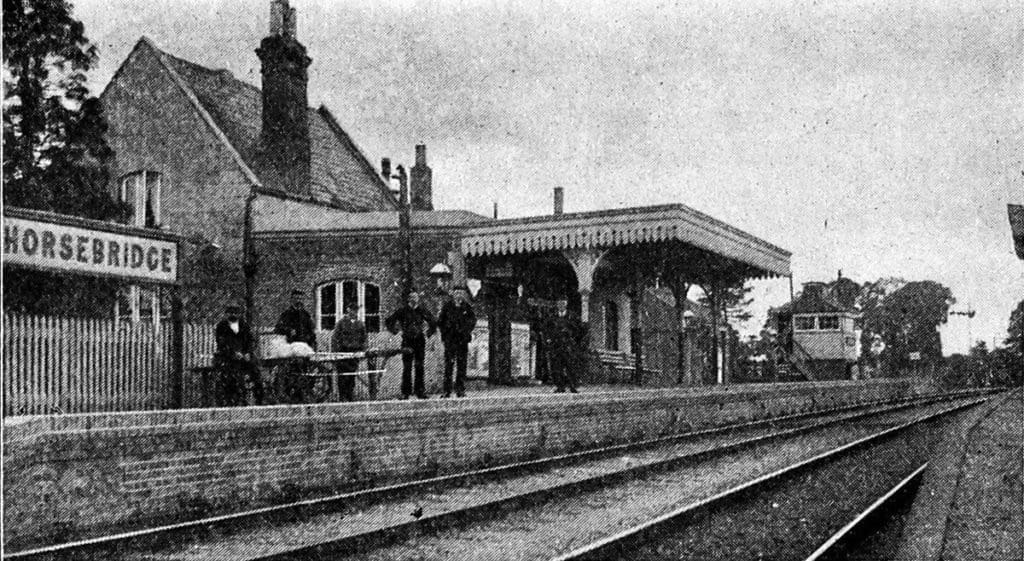

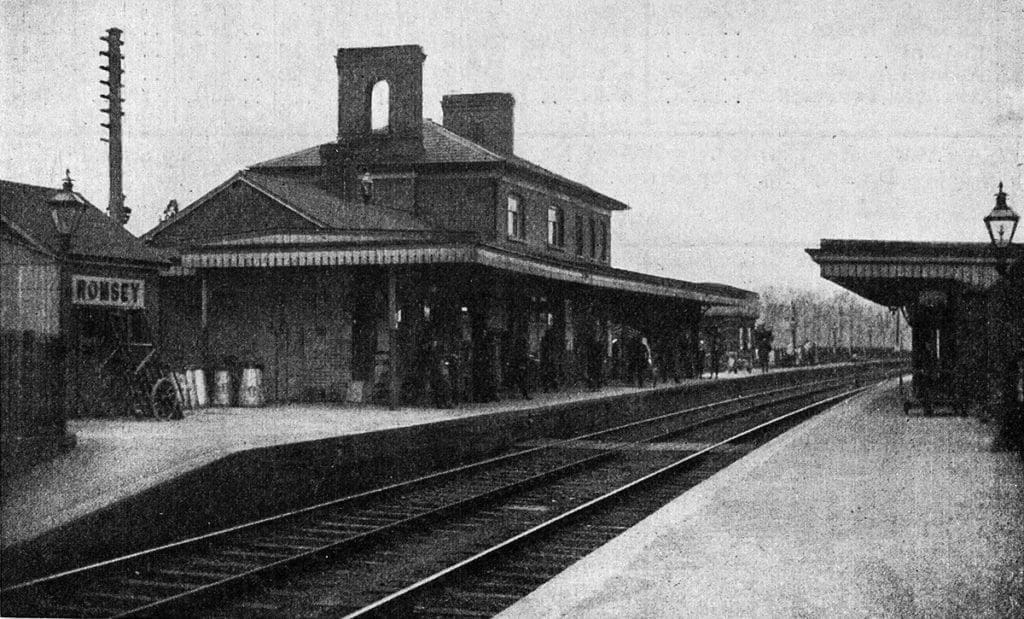
Some years ago a footbridge for the convenience of pedestrians was erected, but persons driving are at times still irritated by a wait at the gates; while trains are standing at or approaching the station. The line throughout is very flat, and there are many level crossings between Andover and Horsebridge mostly occupation crossings used by farmers and others whose property adjoins the railway. Andover has a population at the present day of about 8,000.
Just before reaching Clatford station there is a siding branching from the up line and running into the property of Messrs. Tasker & Sons (Waterloo Iron Works), the large agricultural engineers and implement makers. Fullerton, as already stated, is the junction with the spur line from Hurstbourne, and the service on this loop is now performed by rail motor-car. Previous mention has been made of Stockbridge, and we next reach Horsebridge, a pretty wayside station close to the river Test. Mottisfont, our next stopping place, is a charming village with a population of about 520; and about one mile beyond we reach Kimbridge, where there is no station, but is a junction with the line from Salisbury to Romsey. The latter station is also a junction, as just south of the platforms the lines diverge; that on the right going on to Redbridge and Southampton, and the left vid Chandlersford to Eastleigh, the railway town of the South of England. A little before reaching Bomsey an excellent view is afforded of the old canal, which at this point runs at right angles to the railway, and although now much neglected and little used, one can plainly see the old towpath running alongside it.
Romsey is a quaint old market town, and is noted chiefly for its famous abbey of Saxon architecture founded by Edward the Elder, son of Alfred the Great, and rebuilt by Ethelwold, Bishop of Winchester.
Another point of interest about Romsey is the Berthon Boat Works, where the famous collapsible boats, designed by the late vicar, the Rev. E. L. Berthon, are constructed. Romsey closely adjoins the New Forest. It possesses a handsome memorial to the late Lord Palmerston, who at one time resided at Broadlands, now the home of the Hon. Evelyn Ashley.
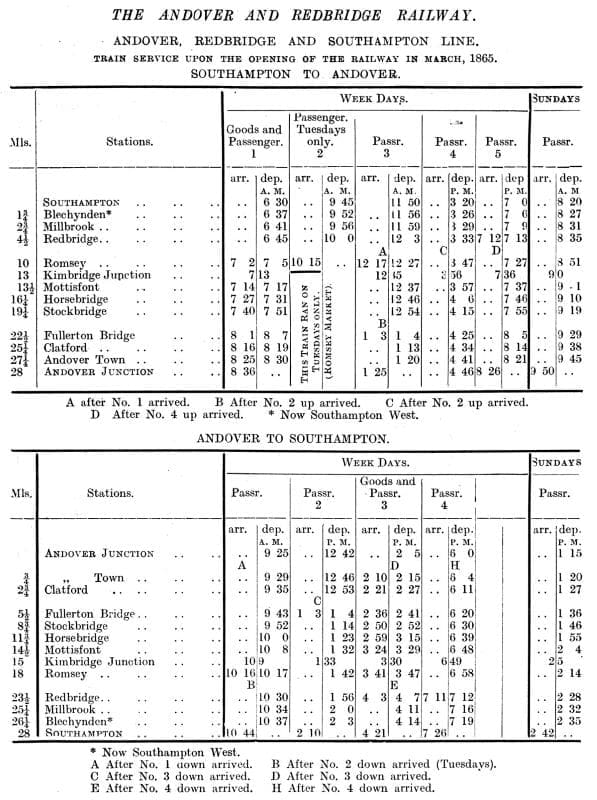
Florence Nightingale’s home was for some years at Embley Park, East Wellow, a few miles from- the town. The population of Romsey is now about 4,500.
Our next stopping point is Nursling, where most of the property adjoining is owned. by the Earl of Northbrook, and where the London and South-Western Railway possesses large ballast pits; and we then pass on to Redbridge, where we get our first sniff of the sea, as the river at this point is tidal, and vessels of considerable size can be seen discharging cargo at the wharves owned by the railway and others. Redbridge is the junction with the Bournemouth and Dorset line, which crosses the river a little north of the station. A branch stores depot of the railway is situated here and large stocks of rails, sleepers and other plant are here stored for use. The wharf is well equipped with steam travelling cranes. This brings us to the southern extremity of the old “sprat and winkle” line, the trains passing on through Millbrook and Southampton West into the Dock station at Southampton.
Since the development of Salisbury Plain as a military centre, a large amount of troop traffic has been brought to this railway, and special trains with soldiers, ete., proceeding to Tidworth, Bulford and other places via Andover Junction or Salisbury are frequently seen. A large amount of sheep traffic is also conveyed in connection with the fairs held at various places in the neighbourhood.
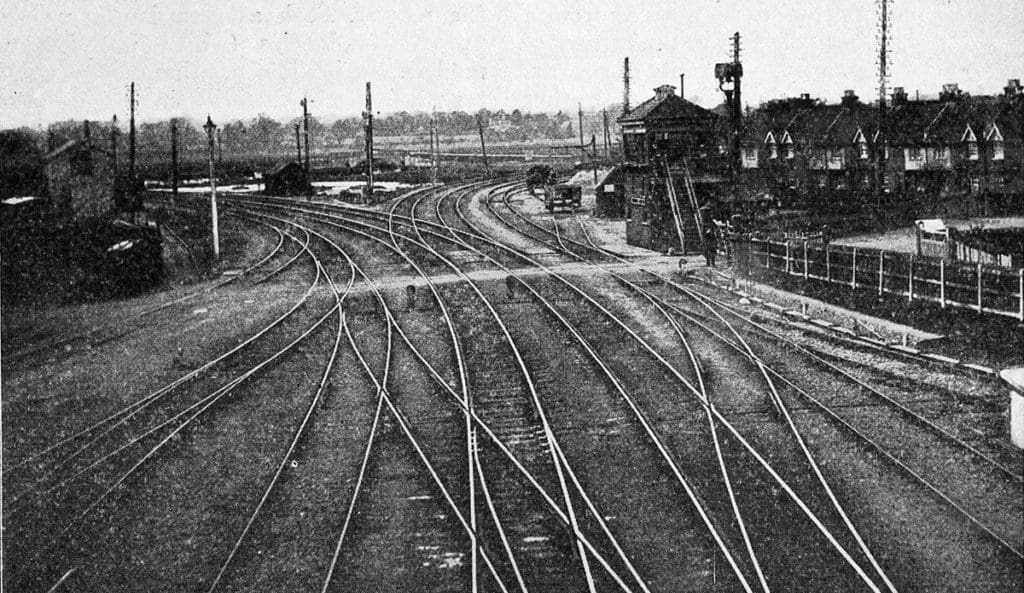

If you enjoyed this archive article, there’s plenty more to be read in The Railway Magazine Archive.
Advert
 Enjoy more Heritage Railway reading in the four-weekly magazine. Click here to subscribe.
Enjoy more Heritage Railway reading in the four-weekly magazine. Click here to subscribe.





